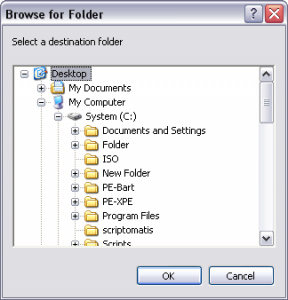Content Type
Profiles
Forums
Events
Everything posted by MHz
-

how to install programs while window please help
MHz replied to coolcliff's topic in Application Installs
http://unattended.msfn.org/ -

Creating user profile (howto apply .reg in cmd)
MHz replied to BoardBabe's topic in Unattended Windows 2000/XP/2003
cmdow @ /HID @echo off set ADMINRIGHTS=SuperDude set KEY="HKLM\SOFTWARE\Microsoft\Windows NT\CurrentVersion\Winlogon" net user %ADMINRIGHTS% /add net localgroup Administratorer %ADMINRIGHTS% /add net accounts /maxpwage:unlimited reg add %KEY% /v DefaultUserName /t REG_SZ /d %ADMINRIGHTS% /f reg add %KEY% /v DefaultPassword /t REG_SZ /d "" /f reg add %KEY% /v AutoAdminLogon /t REG_SZ /d 1 /f That should do it. If required, just add "" to where you think a space maybe in a string. -
Very well stated. It can do whatever is required. No other third party tools should be needed to do any unattended task. AutoIt is the last tool that I would use for installs, and the first tool, I would use for installs. It can control installs which are silent, or can do them in Gui mode. Environment variables can created and used instantly, shortcuts created, etc. The features just keep on going. The Autoit beta has Com and ActiveX support. So Autoit will be able to do the tasks that VBScript are best with, just with a basic langauge. Only the ones who commit to using this powerful language, will enjoy it's benefits. If you need a good free programming editor, then go here.
-
That is no good. Here is the Homepage. Direct links to executables is only stealing bandwidth.
-

Cmd file: some gui that i don't want and some stuf
MHz replied to Jedi82's topic in Application Installs
Nero uses a winrar archive. /S maybe used, instead of /silent? You are doing mydocs.dll twice. Once silent, the other not. Thanks Yzöwl for correction. The others, check in dos window, to ensure the directory names are correct. You may not be able to delete system shell folders. -

Cmd file: some gui that i don't want and some stuf
MHz replied to Jedi82's topic in Application Installs
Inno Setups are very silent with /VerySilent. MSIs use /qn instead of /qb for very silent. -

How to install foxit pdf reader unattended
MHz replied to Benzal's topic in Unattended Windows 2000/XP/2003
All those registry entries are not needed. Only 4 are needed. First run of the program, will add the rest in. Here is an Inno Setup script. For anyone interested. ; Source files should be in folder named {app}, next to this script. [Files] Source: {app}\FoxitReader.exe; DestDir: {app} Source: {app}\rd_eula.txt; DestDir: {app} Source: {app}\readme.txt; DestDir: {app} [Icons] Name: {commonstartmenu}\Foxit PDF Reader; Filename: {app}\FoxitReader.exe; WorkingDir: {app}; IconFilename: {app}\FoxitReader.exe; Comment: PDF Reader; IconIndex: 0 [Setup] OutputBaseFilename=Foxit PDF Reader AppCopyright=Foxit AppName=Foxit PDF Reader AppVerName=Foxit PDF Reader v1.3 DefaultDirName={pf}\Foxit ShowLanguageDialog=yes AppendDefaultGroupName=false DisableProgramGroupPage=true AllowNoIcons=true DirExistsWarning=no [Registry] Root: HKCR; SubKey: .pdf; ValueType: string; ValueData: FoxitReader.Document; Flags: uninsclearvalue Root: HKCR; SubKey: .pdf; ValueType: string; ValueData: application/pdf; ValueName: Content Type; Flags: uninsdeletevalue Root: HKCR; SubKey: FoxitReader.Document\Shell\Open\Command; ValueType: string; ValueData: """{app}\FoxitReader.exe"" ""%1"""; Flags: uninsdeletevalue Root: HKCR; Subkey: FoxitReader.Document\DefaultIcon; ValueType: string; ValueData: {app}\FoxitReader.exe,1; Flags: uninsdeletevalue -
msiexec /a diskeeper.msi This is the basic command for admin install. diskeeper.msi can be changed, depending on the installer name. Just follow the Installer prompts to complete.
-
Windows Registry Editor Version 5.00 [HKEY_CURRENT_USER\Software\Hummingbird\Connectivity\9.00\Exceed] followed by either, Example 1 - REG_SZ "UserDir"="\\\\SRVATD2\\HOME\\%APPDATA%\\Hummingbird\\Connectivity\\9.00\\Exceed\\" or, Example 2 - REG_EXPAND_SZ "UserDir& quot;=hex(2):5c,5c,53,52,56,41,54,44,32,5c,48,4f,4 d,45,5c,25,41,50,50,44,\ 41,54,41,25,5c,48,75,6d,6d,69,6e,67,62,69,72,64,5c ,43,6f,6e,6e,65,63,74,69,\ 76,69,74,79,5c,39,2e,30,30,5c,45,78,63,65,65,64,5c ,00Done with Maxthon (IE based rendering engine)
-
@Nologic Noticed you have Network drive in there. Your covering the bases. @maniaq Here is my simple RunOnceEx, with the _FindCD() function, that I use. It does just the CDRom, which is enough for most.
-
Basically, you can test single parts of your installation. Make a bare WinXP + SP2 ISO. Install windows from this ISO. Install Virtual PC Additions, then reboot. Shut down the Virtual OS. Look at the Virtual PC Console window. You should see buttons New, Settings, Remove and Start. Press the Settings button. In the new window, Go to Undo Disks. Check the Enable Undo Disks checkbox. This is optional, Go to Close, at the bottom left. Select Automatically close without a message and:. Then select Turn off and delete changes, from the combobox. You should be able to click the OK button to complete the setup. You now have a basic installation of Win XP + SP2. When you boot it up, any changes made, is saved to a separate file, not to the Virtual OS image. This separate file, will be deleted, when you shut it down. This gives a perfect testing environment. Start You can now, boot up the Virtual OS. If you have for example, a runonceex method, that installs from cd. You should see in the toolbar, CD. In the dropdown, you will see Capture CD Image. Select this, and select the Win XP + SP2 ISO image with all your software on it. It should mount on the Virtual OS. You can then browse the mounted ISO, and click on the Runonceex.cmd. This will add the entries to the registry. All you need to do then, is reboot the Virtual OS. The Virtual OS will reboot into the runonceex period, and will start installing the software. This is the similar as testing your software before, but you already have a clean installation of windows. If the software installation, did not work, as it should. Then you you can shutdown the Virtual OS, and the changes made, example, all of your software installations, are deleted. You can make changes required to your unattended ISO, and test again, by going to the Start, on this page, in blue. Your fresh installation of Win XP + SP2 is ready, when you boot Virtual PC again. This enables you, to quickly test your software installation, without installing windows with it, each time.
-

switchs for Software made by WISE Installer ?
MHz replied to caomeisanhao's topic in Application Installs
Sure are more switches, I use this. -

Protecting UACD ! -Some Insight
MHz replied to MOONLIGHT SONATA's topic in Unattended Windows 2000/XP/2003
The files and folders are completely hidden, even in DOS. AFAIK, only program that can read them is EasyBoot. -
You will need to do a normal installation. Choose the language, at the start of install. When it is installed, you will have a file, in the installation directory called mp3tag.lng . Copy this file into your installation directory, when you do your silent install. This would be your best chance, with the current NSIS Installer.
-

Stop US Input Language - Australia
MHz replied to uqdblack's topic in Unattended Windows 2000/XP/2003
I use US keyboard settings and American English. It is the defaults. So no hassles with language bar etc. Everything still looks ok, without the hassles. -

Stop US Input Language - Australia
MHz replied to uqdblack's topic in Unattended Windows 2000/XP/2003
Hi Daniel, I just allow the default US keyboard layout, to be set. This way, you do not have to specify any different. I would doubt, that you would notice any variation, between the 2 layouts. -
Not lazy, but smart. If your OS installation is fine, then testing your application installs, can be done in a separate process. Virtual PC, can be setup to not save changes, so you can test your application installations very quickly. It only takes a reboot to test.
-
It is a wise installer. Just use setup.exe /x path to extract
-
Updated to version 1.4. Please see 1st post for information and download link.
-
A verbal warning of any conflict, will not be shown, unless it coded, to do so. Changes in the context menu, while using both, is enough notice for a possible conflict. When a shell problem does happen, it will be Dr.Watson running in the background, doing a crashdump. When you have 3 healthy systems, it maybe fine, but if some problem, lowers the defenses of your system, that is when any other problems, tend to surface. The best way to answer this logically? Why have 2 DLLs to do the same task? These are pictures of CMenu only. With the exact, same task: This is a builtin feature of the DLL, that CMenu uses. CMenu does the other DLLs task plus many more. The other DLL is 25% larger, then the CMExt.dll ??? I think my recommendation is a good one. I did not say you could not have both, but do strongly recommend not to.
-
Seems like you had VMWare previously installed on your pc, but the test pc did not. So this script was not created from a machine, with the config files removed? Options: Maybe as blinkdt has stated. Or use AutoIt to fileInstall() the config files, then install VMWare. Can be done within the same script. Or perhaps the config, is in registry. That would be easier to apply. Or repair the script, to include the config setup. I do not use VMWare, so cannot correct the script for you. Edit: Found BAtman75 script. Looks similar, so something has changed? Or same fault in both?
-
Correct. That is as silent, as it gets. /? can be used, for help.
-
Ahh, just googled reg2exe, Half a second, and got the answer. Look here.. Hope you come back for the answer.
-
The best method for a short list like that. Add them to registry, then just export them out again, in the suitable format.



